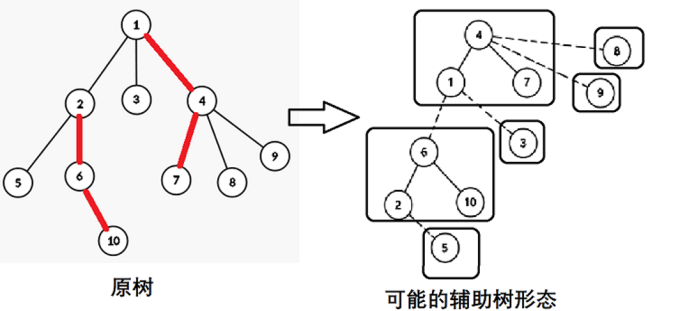建议在右侧的设置按钮中打开阅读器模式阅读
虽然基于 Splay,但是并没有 Splay 难调
LCT 简介
LCT 是一种解决动态树问题的算法,就是在树链剖分的基础上可以断开或连接边(当然保证还是一棵树)。
那么对于这种问题,自然就不能用重链剖分来解决,这时便需要一个新的组合——实链剖分+Splay
模板题看这里
实链剖分
对于一个点连向它所有儿子的边,我们自己选择一条边进行剖分,我们称被选择的边为实边,其他边则为虚边。对于实边,我们称它所连接的儿子为实儿子。对于一条由实边组成的链,我们同样称之为实链 —— Oi-Wiki
Splay
先放两篇博客,毕竟这种被 FHQ 吊打的数据结构不太想写,也只需要会一点点就好了
「学习笔记」平衡树——splay 一
「学习笔记」平衡树——splay 二
算法讲解
思路
对于一棵树,我们将它剖成若干条实链:

如图所示,整棵树被剖分成{1,4,7},{2,6,10},{3},{5},{8},{9}这些实链。
所以我们可以以深度为关键字,对每条连用一棵 Splay 来维护。
但是我们如何对于原树进行维护?可以对每一棵 Splay 的链顶的父亲节点进行记录,但是从原树上的父亲不会向它连边
具体实现可以将链顶的 fa 值设为链头在原树上的父节点
然后就可以用一棵新的树,也就是辅助树替代掉原树:

这就是 LCT 大致的思路。
实现
先鸽一下……
本人用的结构体写法……
Splay 部分
结构体:
1
2
3
4
5
| struct node
{
int val, xval;
int ch[2], fa, lazy_rev;
} tr[N];
|
上传与下放:
1
2
3
4
5
6
7
8
9
10
11
12
13
14
15
| void pushup(int x)
{
tr[x].xval = tr[tr[x].ch[0]].xval ^ tr[tr[x].ch[1]].xval ^ tr[x].val;
}
void pushdown(int x)
{
if(tr[x].lazy_rev)
{
int p;
if(p = tr[x].ch[0]) swap(tr[p].ch[0], tr[p].ch[1]), tr[p].lazy_rev ^= 1;
if(p = tr[x].ch[1]) swap(tr[p].ch[0], tr[p].ch[1]), tr[p].lazy_rev ^= 1;
}
tr[x].lazy_rev = 0;
}
|
旋转:
1
2
3
4
5
6
7
8
| void rotate(int x)
{
int y = tr[x].fa, z = tr[y].fa, k = getch(x);
if(!isroot(y)) tr[z].ch[getch(y)] = x; tr[x].fa = z;
tr[y].ch[k] = tr[x].ch[k ^ 1]; tr[tr[y].ch[k]].fa = y;
tr[x].ch[k ^ 1] = y, tr[y].fa = x; pushup(y);
}
|
伸展:
1
2
3
4
5
6
7
8
9
10
11
12
| void splay(int x)
{
update(x);
while(!isroot(x))
{
if(!isroot(tr[x].fa)) rotate(getch(x) ^ getch(tr[x].fa) ? x : tr[x].fa);
rotate(x);
}
pushup(x);
}
|
LCT 部分
一共十个函数……
判断是哪棵子树:
1
2
3
4
| int getch(int x)
{
return tr[tr[x].fa].ch[1] == x;
}
|
判断是否为根:
1
2
3
4
5
| bool isroot(int x)
{
return tr[tr[x].fa].ch[0] != x && tr[tr[x].fa]. ch[1] != x;
}
|
操作从根到x上的所有子节点的懒标记:
1
2
3
4
5
6
| void update(int x)
{
if(!isroot(x)) update(tr[x].fa);
pushdown(x);
}
|
下面是整个 LCT 中最核心的操作——将 x 到根打通为实链(仅是从 x 到根路径上的点)
对于在 x 点时,显然不会有实链,所以将 x 伸展到根后直接断开 x 与下面的连接
在其他点时,伸展到根后两部分:左儿子——在当前链上深度小于当前点的部分,右儿子——在当前链上深度大于当前点的部分。那么因为要把当前点与上一次的连接,就断开与右儿子的连接,将上一次操作的点连在右儿子上。
一直这样操作直到连到原树树根。
1
2
3
4
5
6
7
8
9
10
| void access(int x)
{
int p = 0;
for(; x; p = x, x = tr[x].fa)
{
splay(x);
tr[x].ch[1] = p;
pushup(x);
}
}
|
将x换为原树的根:
1
2
3
4
5
6
7
| void makeroot(int x)
{
access(x);
splay(x);
swap(tr[x].ch[0], tr[x].ch[1]);
tr[x].lazy_rev ^= 1;
}
|
将x~y打通成实链:
1
2
3
4
5
6
7
| int split(int x, int y)
{
makeroot(x);
access(y);
splay(y);
return y;
}
|
找x所在原树的根:
1
2
3
4
5
6
7
8
9
10
11
12
13
14
| int find(int x)
{
access(x);
splay(x);
pushdown(x);
while(tr[x].ch[0])
{
x = tr[x].ch[0];
pushdown(x);
}
splay(x);
return x;
}
|
连接x,y点:
1
2
3
4
5
| void link(int x, int y)
{
makeroot(x);
if(find(y) != x) tr[x].fa = y;
}
|
断开x, y:
1
2
3
4
5
6
7
8
9
10
11
12
13
14
15
| void cut(int x, int y)
{
split(x, y);
if(tr[y].ch[0] == x && tr[x].ch[1] == 0)、
{
tr[y].ch[0] = tr[x].fa = 0;
pushup(y);
}
}
|
修改x的点权:
1
2
3
4
5
6
| void fix(int x, int v)
{
splay(x);
tr[x].val = v;
pushup(x);
}
|
完整代码
70行极限压行,真男人才懂得压行的魅力~
1
2
3
4
5
6
7
8
9
10
11
12
13
14
15
16
17
18
19
20
21
22
23
24
25
26
27
28
29
30
31
32
33
34
35
36
37
38
39
40
41
42
43
44
45
46
47
48
49
50
51
52
53
54
55
56
57
58
59
60
61
62
63
64
65
66
67
68
69
70
|
#include <bits/stdc++.h>
#define int long long
#define FH signed
using namespace std;
const int N = 1e5 + 10;
struct node {int val, xval, ch[2], fa, lazy_rev;} tr[N];
int getch(int x) {return tr[tr[x].fa].ch[1] == x;}
void pushup(int x) {tr[x].xval = tr[tr[x].ch[0]].xval ^ tr[tr[x].ch[1]].xval ^ tr[x].val;}
void pushdown(int x)
{
if(tr[x].lazy_rev)
{
int p;
if(p = tr[x].ch[0]) swap(tr[p].ch[0], tr[p].ch[1]), tr[p].lazy_rev ^= 1;
if(p = tr[x].ch[1]) swap(tr[p].ch[0], tr[p].ch[1]), tr[p].lazy_rev ^= 1;
}tr[x].lazy_rev = 0;
}
bool isroot(int x) {return tr[tr[x].fa].ch[0] != x && tr[tr[x].fa]. ch[1] != x;}
void update(int x) { if(!isroot(x)) update(tr[x].fa); pushdown(x);}
void rotate(int x)
{
int y = tr[x].fa, z = tr[y].fa, k = getch(x);
if(!isroot(y)) tr[z].ch[getch(y)] = x; tr[x].fa = z;
tr[y].ch[k] = tr[x].ch[k ^ 1]; tr[tr[y].ch[k]].fa = y;
tr[x].ch[k ^ 1] = y, tr[y].fa = x; pushup(y);
}
void splay(int x)
{
update(x);
while(!isroot(x)) {if(!isroot(tr[x].fa)) rotate(getch(x) ^ getch(tr[x].fa) ? x : tr[x].fa); rotate(x);}
pushup(x);
}
void access(int x)
{
for(int p = 0; x; p = x, x = tr[x].fa)
splay(x), tr[x].ch[1] = p, pushup(x);
}
void makeroot(int x) {access(x), splay(x), swap(tr[x].ch[0], tr[x].ch[1]), tr[x].lazy_rev ^= 1;}
int split(int x, int y) {makeroot(x), access(y) , splay(y); return y;}
int find(int x)
{
access(x), splay(x), pushdown(x);
while(tr[x].ch[0]) x = tr[x].ch[0], pushdown(x); splay(x);
return x;
}
void link(int x, int y) {makeroot(x); if(find(y) != x) tr[x].fa = y;}
void cut(int x, int y) {split(x, y); if(tr[y].ch[0] == x && tr[x].ch[1] == 0) tr[y].ch[0] = tr[x].fa = 0, pushup(y);}
void fix(int x, int v) {splay(x), tr[x].val = v, pushup(x);}
FH main()
{
int n, m;
cin >> n >> m;
for(int i = 1; i <= n; i ++) cin >> tr[i].val;
for(int i = 1; i <= m; i ++)
{
int opt, x, y;
cin >> opt >> x >> y;
if(opt == 0) cout << tr[split(x, y)].xval << "\n";
if(opt == 1) link(x, y);
if(opt == 2) cut(x, y);
if(opt == 3) fix(x, y);
}
return 0;
}
|
说句闲话,这是我生日过的紫题呢~~~
完结撒花~~~


